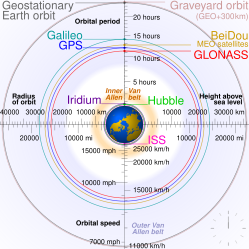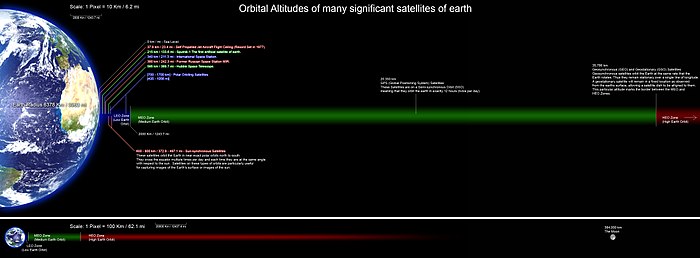Low Earth orbit
F2012)

Comparison of GPS, GLONASS, Galileo and Compass (medium earth orbit) satellite navigation system orbits with the International Space Station, Hubble Space Telescope and Iridium constellation orbits, Geostationary Earth Orbit, and the nominal size of the Earth.[a] The Moon's orbit is around 9 times larger (in radius and length) than geostationary orbit.[b]
Contents
Orbital characteristics
Objects in LEO encounter atmospheric drag in the form of gases in the thermosphere (approximately 80–500 km up) or exosphere (approximately 500 km and up), depending on orbit height. Objects in LEO orbit Earth between the atmosphere and below the inner Van Allen radiation belt. The altitude is usually not less than 300 km for satellites, as that would be impractical due to atmospheric drag.The orbital velocity needed to maintain a stable low earth orbit is about 7.8 km/s, but reduces with increased orbital altitude. The delta-v needed to achieve low earth orbit starts around 9.4 km/s. Atmospheric and gravity drag associated with launch typically adds 1.5–2.0 km/s to the delta-v launch vehicle required to reach normal LEO orbital velocity of around 7.8 km/s (28,080 km/h).
Equatorial low Earth orbits (ELEO) are a subset of LEO. These orbits, with low inclination to the Equator, allow rapid revisit times and have the lowest delta-v requirement of any orbit. Orbits with a high inclination angle to equator, are usually called polar orbits.
Higher orbits include medium Earth orbit (MEO), sometimes called intermediate circular orbit (ICO), and further above, geostationary orbit (GEO). Orbits higher than low orbit can lead to early failure of electronic components due to intense radiation and charge accumulation.
Use of LEO
Roughly half an orbit of the ISS
A low earth orbit is simplest and most cost effective for a satellite placement and provides high bandwidth and low communication latency.
Examples
- Earth observation satellites and spy satellites use LEO as they are able to see the surface of the Earth more clearly as they are not so far away. They are also able to traverse the surface of the Earth. A majority of artificial satellites are placed in LEO, making one complete revolution around the Earth in about 90 minutes
- The International Space Station is in a LEO about 400 km (250 mi) above the Earth's surface.[3]
- Since it requires less energy to place a satellite into a LEO and the LEO satellite needs less powerful amplifiers for successful transmission, LEO is still used for many communication applications. Because these LEO orbits are not geostationary, a network (or "constellation") of satellites is required to provide continuous coverage. (Many communication satellites require geostationary orbits, and move at the same angular velocity as the Earth. Some communications satellites including the Iridium phone system use LEO.)
- Lower orbits also aid remote sensing satellites because of the added detail that can be gained. Remote sensing satellites can also take advantage of sun-synchronous LEO orbits at an altitude of about 800 km (500 mi) and near polar inclination. ENVISAT is one example of an Earth observation satellite that makes use of this particular type of LEO.










0 komentar:
Posting Komentar